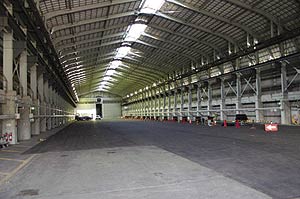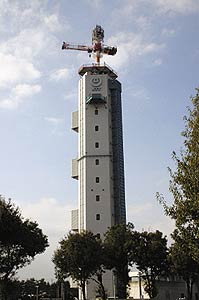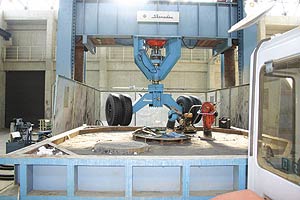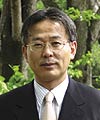Role and mission of Access Network Service Systems Laboratories in NTT
—Under the umbrella of the Information Sharing Laboratory Group, the laboratories that you head research and develop access networks to connect the customer with NTT central offices. The work centers on transmission facilities like cables, utility poles, tunnels, and home optical equipment that act as actual connection points with NTT customers. In view of this work, what is the role and mission of the Access Network Service Systems Laboratories?
Our research covers areas that are quite visible to NTT customers. In a way, we act as a gateway to the use of NTT services. Our mission is to provide services like high-speed Internet access in an enjoyable and stable environment, create new services that customers find attractive and easy to use, and expand the high-speed access market. Our R&D work can therefore be divided into four areas: transmission lines, transmission systems, wireless systems, and civil engineering.
—What is the most difficult challenge for a group of laboratories whose R&D work is closely concerned with commercial and practical products?
In a time of intense competition between operators, NTT has been devoting much energy to R&D, and the theme of high-speed access technology that we are working on has recently been drawn into this vortex of competition. R&D at the Access Network Service Systems Laboratories can therefore have a great effect on NTT's present situation. And for this reason, we cannot be content with just one or two achievements but must work to produce a continuous string of novel results, which is a very difficult task indeed. But at the same time, the results of competition are easy to observe, and we understand well the impact our work can have. We are highly motivated to come out on top.
Another characteristic of R&D at our laboratories is that access systems include many outdoor products that are easily affected by weather and temperature conditions. This means that we must create products that are sufficiently durable. We must also minimize the effects of installation and repair work on nearby residents and on the environment as well. This impels us to research construction methods that shorten construction periods and reduce noise and vibration.
R&D of technologies for achieving responsive, diversified, and advanced services

Photo 1. Free-bending optical fiber cord.
—Mr. Shinohara, could you give us an example of a recent research achievement?
I think our most conspicuous achievement is that the number of FTTH (fiber to the home) subscribers has surpassed the number of ADSL (asymmetric digital subscriber line) subscribers. Of course, this is the result of NTT-wide efforts including those of NTT operators and other research laboratories, but I take great pride in the fact that the results of our long-term research as part of the NTT organization have made a significant contribution to this achievement.
Over these last few years, after focusing simply on technologies for achieving cost-efficient optical communications, we have been working to develop technologies for providing responsive, diversified, and advanced optical services to respond effectively to next-generation needs and the demand for easier-to-use products. The results of these efforts include the development of free-bending optical fiber cord that can be bent, folded, and even knotted, making it as easy to use as metallic cable (Photo 1), and the development of optical-fiber connection and enclosure technologies for enhancing our responsiveness to ever growing needs. We have also been working to eliminate the "digital divide" by developing a wireless IP (Internet protocol) access system that can provide high-speed Internet access by wireless means instead of by optical fiber within a range of about 1 km from a base station. This development has made a great contribution to eliminating differences in access services between urban and rural areas.
—It's been 30 years since NTT first set FTTH as one if its R&D goals, but it is only recently that FTTH deployment has begun to take off after 20 years of dedicated research. For this to happen, were there any R&D breakthroughs or other reasons that provided an opportunity for growth?
I think one reason is that, after 20 long years of hard work and perseverance, the technologies that we originally imagined, such as those for reducing costs, finally came to fruition. Another reason is the coming of the Internet, which made it easy for customers to understand the usefulness of an optical network. I believe that an important factor behind Japan having the highest number of optical users in the world is the national character of the Japanese people, who find value in high-speed access. Foreseeing the coming of the optical era back in the mid-80s, NTT made the right preparations, making both monetary and technological investments. These efforts were not in vain, for when NTT came up against severe competition in the high-speed ADSL market, it entered the battle with firm technologies that produced effective results.
Enhancing operation, maintenance, and management technologies for the future
—What are some important research topics or issues for the future?
First and foremost is the development of enhanced optical fiber/cable technologies to achieve even greater convenience and ease of use. We also attach great importance to enhancing operation, maintenance, and management technologies so that we can continue to provide sophisticated services and expand NTT's customer base. And, while this is a mission not just for us but also for all NTT R&D, we want to create services and usage formats that will enable our customers to enjoy the wonderful aspects of optical technology while increasing revenues at the same time.
—Are you faced with any issues related to civil engineering or wireless communications?
The civil-engineering area provides important support for the communication networks in Japan. Against a background of aging underground conduits, we are developing technologies for facilitating the management of repairs while maintaining a low-cost peripheral environment with the aim of ensuring a stable lifeline for society.
As far as wireless communications is concerned, eliminating the digital divide is an important issue, as I mentioned before. We consider the provision of a triple-play service that bundles Internet, video, and telephone services to be a matter of great urgency. We are also developing mobile broadband technologies that will enable users inside trains, ships, airplanes, and other vehicles that travel great distances to receive high-speed access services.
—Compared with other developed countries, which have been running cables underground to minimize aerial cables, Japan has a much higher proportion of aerial cables. What are Japan's plans for converting to underground cables in the future?
At present, we do have a small number of underground cables in conduits shared with power and cable-TV companies based on national policy, and we are promoting the use of underground cables in designated areas. From here on, I would like to work together with the government and other operators to pursue the issue of conversion further.
Producing results through collaboration between engineering staff and research staff
— Mr. Shinohara, what is the work environment like inside the Access Network Service Systems Laboratories?
A major feature of the Access Network Service Systems Laboratories is that engineers make up about half of the staff. In general, it can be said that engineering work sets clear-cut goals such as reducing costs and achieving greater efficiencies with the aim of commercializing the results of R&D. Research work, on the other hand, tends to delve deeper and deeper into a topic over the long term toward goals or dreams originating with the researcher himself. Our aim, therefore, is to achieve our objectives through a collaboration between engineers and researchers, where the former form teams and work toward their goals and the latter pursue personal themes in a more independent, individualistic style. Some of our facilities are shown in Photos 2, 3, and 4.

Photo 2. Field-experiments building.
This is the largest comprehensive field-experiments building in NTT Access Network Service Systems Laboratories. This building was formerly used to test the durability of underground structures by actually driving trucks over them. At present, it is used for the annual Tsukuba Forum sponsored by the Access Network Service Systems Laboratories to house booths and present research achievements to about 10,000 visitors.

Photo 3. High-rise experimental building.
This structure was constructed to investigate the effects of earthquakes and temperature fluctuations on vertical cables installed in high-rise buildings. With three underground floors and 12 stories above ground, it reaches a height of 63 m. Situated in an area with no other high-rise structures, it attracts a lot of attention. The NTT "dynamic loop" logo at the top of the building is the largest representation of this logo in the country.

Photo 4. Wheel-load experimental equipment.
This equipment, which features a new pressure-application system, is used inside the large field-experiments building to perform durability tests on manholes and underground tunnels that house communication facilities. The same building includes a temperature-fluctuation laboratory that can provide test environments with temperatures ranging from –20°C to 50°C and adjustable humidity.
—What would you like to say to staff members?
I say this all the time to young staff members: Please think in terms of "autonomy and heteronomy." The work of technology development toward commercialization must be centered on assessments made by customers or operators, that is, assessments made by someone else. This is heteronomy. Research, on the other hand, does not depend solely on outside assessments. A researcher must have confidence in his or her own research and must have a dream to work toward. This is autonomy.
Engineers or technology developers recognize products of other operators and manufacturers and keep customer assessments in mind, while research ers only need to compare their present work with their own past research. Of course, there are exceptions to this rule, but it is very important to determine whether you think of your work in terms of autonomy or heteronomy.
I also often say: Don't forget the dreams that you brought with you on entering the company. Despite being presented with many options, you selected a research organization of a telecommunications company, which means that you must have had a dream or desire about the role that you wanted to play within the company. At any rate, be absorbed in your work with the goal of fulfilling whatever dream you might have.
I believe that it is essential for staff of my generation to create an environment in which young researchers—who will take up the R&D challenges of tomorrow—can pursue their work with great motivation and optimism.
—In closing, could you give us your mid-term and long-term outlook for the future?
Let me first say that the ongoing provision of even better services for our customers in a stable, uninterrupted manner is a standard that we set for ourselves. To this end, I feel that results achieved from R&D of operation and maintenance technologies will become increasingly important, as I mentioned earlier. Of course, to continue to develop and provide new services and technologies that are especially beneficial to customers, we must accumulate and combine research in various fields. At the same time, an increase in the number of customers and the appearance of new technologies will no doubt change the research themes and important issues that we must tackle. However, the ongoing provision of a stable access environment, which is absolutely necessary for the realization of a ubiquitous broadband era, is one standard that I don't think will change for us in the years to come.
↑ TOP

